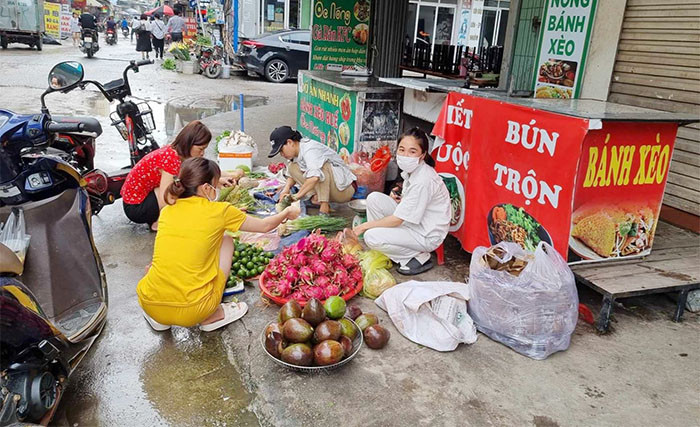The Institute of Workers and Trade Unions (Vietnam General Confederation of Labor) has published a survey showing that most workers' current income does not meet their expenses, in some cases only meeting 45% of their needs.
Ms. Pham Thi Thu Lan, Deputy Director of the Institute of Workers and Trade Unions (Vietnam General Confederation of Labor) said that the unit conducted a survey of nearly 3,000 workers in 6 provinces and cities. The survey showed that 52.3% of workers worked overtime, an average of 1.75 hours/day. Most of the surveyed workers volunteered to work overtime to earn more income and improve their lives.

Workers at Bac Thang Long Industrial Park, Hanoi sell goods to earn extra income.
In 2024, the shortage of orders is forecast to continue, with 17.2% of surveyed businesses saying that the shortage of orders in 2024 will increase compared to 2023.
Basic salary including full working hours is more than 6 million VND/month, 8.4% higher than the survey in March 2022, higher than the regional minimum wage from 37.5% to 51.9% depending on the region.
Spending in 2023 increased by 19% compared to 2022, with total spending of nearly 12 million VND/month. Of which, they spent more on food, accounting for nearly 70%.
According to the survey, more than 24% of workers can barely meet basic expenses, while up to 75.5% of workers said their current income does not meet their spending needs, and in some cases, their income only meets 45% of their spending needs.
Ms. Pham Thi Thu Lan informed that more than 53% of workers said that because of salary, they considered getting married, not having children, and that their salary was not enough to take care of their children in the city, so they had to send money back to their hometown.
Regarding housing, more than 23% of salary is spent on rent, an average of 1.8 million VND/month including electricity and water. In addition, most of the 157 enterprises participating in the survey have established a salary scale, the lowest level is equal to the regional minimum wage.
23.4% of enterprises, when determining the regional minimum wage, have cut out two allowances: hazardous allowance and training allowance. Most enterprises adjust the regional minimum wage according to the Government's decree, but 10.1% still adjust it lower by 6%.
According to Mr. Nguyen Thai Duong, Vice President of the Vietnam Textile and Garment Trade Union, union officials want workers to have jobs and increase their income. However, businesses have faced many difficulties in recent times. In the first 6 months of the year, the export turnover of the textile and garment industry decreased by more than 20%, equivalent to nearly 4 billion USD. The number of unemployed workers reached more than 600,000 people. Therefore, this situation will affect the wages of workers and the minimum wage that will be negotiated soon. Increasing the regional minimum wage for those who do not meet the regional minimum wage is meaningful. Some businesses with workers who do not meet the regional minimum wage have had to compensate for the wages of those who are higher. However, for those with higher wages, such as the average wage in the textile and garment industry in the first 6 months of the year was 8.8 million VND/person, when the wage increases, the actual income does not increase.
According to Tin Tuc Newspaper